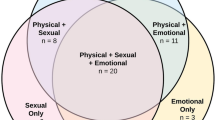Abstract
Female Genital Mutilation or Cutting (FGM/C) is a human rights violation used to claim asylum in the US. We sought to understand the nature of these asylum requests. Analysis of 121 FGM/C-focused medical affidavits, and 132 legal case reports. Of 119 eligible affidavits analyzed, 84% were reportedly cut: 4.6% Type I, 84.6% Type II, 16.5% Type III. Average age: 9. Reported acute effects: bleeding (76.3%), infection (27.6%), shock (6.7%), broken bones (2.7%), and hospitalization (2.7%). Reported chronic issues: intercourse difficulty (81.7%), pregnancy complications (54.2%), chronic pain (42.4%), scarring (37.3%), urinary difficulty (31.8%). Psychological consequences included PTSD (72.4%), depression (65.9%), anxiety (51.1%), and lack of trust (10.1%). Co-occurring abuses included domestic violence (62.4%), forced marriage (46%), rape (33.3%), torture (33.3%), child marriage (31.3%), assault due to LGBTQ + status (2.9%). Women claiming asylum based on FGM/C report high rates of chronic health issues. Their histories suggest FGM/C co-occurs with other forms of gender-based violence.

Similar content being viewed by others
References
World Health Organization (WHO). Female general mutilation key facts. https://www.who.int/news-room/fact-sheets/detail/female-genital-mutilation. Accessed 12 July 2019.
UNICEF. Female genital mutilation. Key Data. Updated 2018. Geneva. Switzerland. UNICEF DATA. https://data.unicef.org/topic/child-protection/female-genital-mutilation/. Accessed 12 July 2019.
Too many. https://www.28toomany.org/. Accessed 12 July 2019.
Universal Declaration of Human Rights. https://www.un.org/en/universal-declaration-human-rights/index.html. Published October 6, 2015. Accessed 12 July 2019.
Convention on the elimination of all forms of discrimination against women. https://www.un.org/womenwatch/daw/cedaw/. Accessed 12 July 2019.
International Covenant on Civil and Political Rights. https://www.ohchr.org/en/professionalinterest/pages/ccpr.aspx. Accessed 12 July 2019.
International Covenant on Economic, Social and Cultural Rights. https://www.ohchr.org/en/professionalinterest/pages/cescr.aspx. Accessed 12 July 2019.
Convention on the Rights of the Child. [Article 19 of the Convention,UN General Assembly, Convention on the Rights of the Child, 20 November 1989, United Nations, Treaty Series, vol. 1577, p. 3 ]. https://www.ohchr.org/en/professionalinterest/pages/crc.aspx. Accessed 12 July 2019.
US Department of Justice. Matter of Kasindja. https://www.justice.gov/sites/default/files/eoir/legacy/2014/07/25/3278.pdf. (1996). Accessed 12 July 2019.
UN General Assembly, Convention relating to the status of refugees, 28 July 1951, United Nations, Treaty Series, vol. 189, p. 137. UNHCR. https://www.unhcr.org/1951-refugee-convention.html. Accessed 12 July 2019.
Invisible and Involuntary: female genital mutilation as a basis for asylum. https://cornelllawreview.org/articles/invisible-and-involuntary-female-genital-mutilation-as-a-basis-for-asylum/. Accessed 1 June 2018.
Female Genital Mutilation or Cutting (FGM/C). USCIS. https://www.uscis.gov/fgmc. Accessed 1 June 2018.
United Nations High Commissioner for Refugees. UNHCR Protection Policy and Legal Advice Section Division of International Protection Services. Guidance Note on Refugee Claims Relating to Female Genital Mutilation. Geneva. May 2009. https://www.refworld.org/pdfid/4a0c28492.pdf Accessed 1 June 2018.
Kim Y. CRS Report to Congress. Asylum law and female genital mutilation: recent developments. 2008. https://fas.org/sgp/crs/misc/RS22810.pdf. Accessed 1 June 2018.
Schaefer K. Asylum granted based on fgm and domestic violence. Schaefer Law Firm. https://immigrationidaho.com/asylum-granted-fgm-domestic-violence/. Published May 31, 2011. Accessed 1 June 2018.
Zakari Z. FGM asylum cases forge new legal standing. Women’s eNews. https://womensenews.org/2008/11/fgm-asylum-cases-forge-new-legal-standing/. Accessed 1 June 2018.
A Parent’s predicament: theories of relief for deportable parents of children who face female genital mutilation. https://cornelllawreview.org/articles/a-parents-predicament-theories-of-relief-for-deportable-parents-of-children-who-face-female-genital-mutilation/. Accessed 1 June 2018.
Female genital mutilation/cutting: Asylum claims and appeals|Rights in Exile Programme. https://www.refugeelegalaidinformation.org/female-genital-mutilationcutting-asylum-claims-and-appeals. Accessed 1 June 2018.
FGM: challenges for asylum applicants and officials|Forced Migration Review. https://www.fmreview.org/climatechange-disasters/flamand.html. Accessed 1 June 2018.
UN Committee Against Torture (CAT), General Comment No. 2: Implementation of Article 2 by States Parties, 24 January 2008, CAT/C/GC/2, para 18; Report of the UN Special Rapporteur on violence against women (E/CN.4/2002/83, 31 January 2002, introduction, para 6.
Lustig SL, Kureshi S, Delucchi KL, Iacopino V, Morse SC. Asylum grant rates following medical evaluations of maltreatment among political asylum applicants in the United States. J Immigr Minor Health. 2008;10(1):7–15.
Aarts R, van Wanrooij L, Bloemen E, Smith G. Expert medico-legal reports: the relationship between levels of consistency and judicial outcomes in asylum seekers in the Netherlands. Torture. 2019;29(1):36–46.
Rouzi AA, Berg RC, Alamoudi R, Alzaban F, Sehlo M. Survey on female genital mutilation/cutting in Jeddah, Saudi Arabia. BMJ Open. 2019;9(5):e024684.
WHO | Classification of female genital mutilation. WHO. https://www.who.int/reproductivehealth/topics/fgm/overview/en/. Accessed 12 July 2019.
Berg RC, Denison E, Fretheim A. Psychological, social and sexual consequences of female genital mutilation/cutting (FGM/C): a systematic review of quantitative studies. Oslo, Norway: Knowledge Centre for the Health Services at The Norwegian Institute of Public Health (NIPH); 2010. https://www.ncbi.nlm.nih.gov/books/NBK469815/. Accessed 13 July 2019.
Lever H, Ottenheimer D, Teysir J, Singer E, Atkinson HG. Depression, anxiety, post-traumatic stress disorder and a history of pervasive gender-based violence among women asylum seekers who have undergone female genital mutilation/cutting: a retrospective case review. J Immigr Minor Health. 2019;21(3):483–9. https://doi.org/10.1007/s10903-018-0782-x.
Köbach A, Ruf-Leuschner M, Elbert T. Psychopathological sequelae of female genital mutilation and their neuroendocrinological associations. BMC Psychiatry. 2018;18(1):187.
Middelburg A, Balta A. Female genital mutilation/cutting as a ground for asylum in Europe. Int J Refugee Law. 2016;28(3):416–52.
Acknowledgements
The authors wish to thank the expert evaluators who have provided these evaluations to asylum seekers free of charge, and to the survivors who have consented for their anonymized personal information to be used for research and advocacy. We also thank Francesca Nardi, BA, B.C.L./LL.B. Candidate, McGill University Faculty of Law, Montreal, Canada for her assistance with the asylum case analysis.
Funding
We report no funding sources for this project.
Author information
Authors and Affiliations
Contributions
Research idea (RM, DO, KH, RR), Protocol and data extraction plan (RM, DO, KH, RR, KW); Data extraction (KW, CW, RM), Data content analysis (KW, CW, RM, VK, DO), Manuscript drafting, editing and final approval (all authors)
Corresponding author
Ethics declarations
Conflicts of interest
The authors report no conflicts of interest
Additional information
Publisher's Note
Springer Nature remains neutral with regard to jurisdictional claims in published maps and institutional affiliations.
Rights and permissions
About this article
Cite this article
Wikholm, K., Mishori, R., Ottenheimer, D. et al. Female Genital Mutilation/Cutting as Grounds for Asylum Requests in the US: An Analysis of More than 100 Cases. J Immigrant Minority Health 22, 675–681 (2020). https://doi.org/10.1007/s10903-020-00994-8
Published:
Issue Date:
DOI: https://doi.org/10.1007/s10903-020-00994-8




